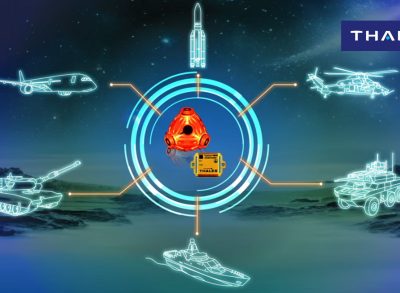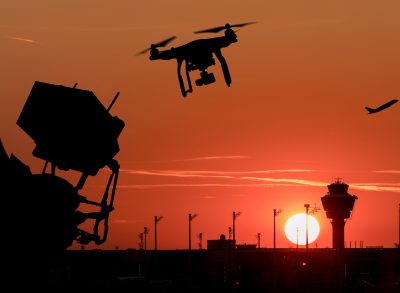Flying in 4D
4D trajectory is at the core of SESAR and will enable more direct flights with benefits for passengers, airlines and the environment. Pascal Combe, THALES Avionics’ SESAR Project Manager, tells us more about Thales’s involvement in this program.

In order to cope with ever escalating growth in air traffic and environmental constraints, trajectory management was identified as one of the key pillars of the modernization of Europe’s ATM (Air Traffic Management) system under the SESAR program. With the 4D concept, aircraft will be able to automatically adapt their speed and trajectory in-flight to arrive at a given point in space at a time pre-agreed with the Air Traffic Control.
This concept aims to connect aircraft and ground systems to optimize trajectory in three dimensions (latitude, longitude and altitude) plus time with real-time exchange of trajectory information between aircraft and Air Navigation Service Providers (ANSPs). This means that 4D trajectory management has huge potential to create more efficient aircraft operations and arrival sequences, while reducing fuel burn and aviation’s environmental footprint, while also further enhancing safety.
How can these targets be reached?
As the trajectory of each aircraft is defined in detail in advance, with local conditions and other airspace users taken into account, the overall predictability and efficiency of air traffic will be enhanced. The 4D trajectory will also improve safety as it decreases the workload for pilots and air traffic controllers, who will thus have more time to monitor safety aspects. Knowing the exact trajectory and timing for each flight means that aircraft can optimize their routing and fuel usage, which will lower costs and also reduce CO2 emissions per flight. In addition, 4D trajectories can take local needs into account in terms of noise and other forms of pollution, and avoid unnecessary over-flights.
What is the difference between 4D trajectory and I4D?
The concept is to ultimately use 4D trajectories from take-off to landing, even up to airport surface management. As this will require complex upgrades on ground infrastructure, SESAR has decided to take steps towards this eventuality.
I-4D operations – I for initial – consist of using airborne computed predictions in order to establish in advance a sequence for aircraft to converge on a merging point in a congested area. This requires strict and constant coordination between the aircraft and Air Traffic Control (ATC) ground systems. A result of this coordination is an allocated time constraint, known as the Controlled Time of Arrival (CTA), at the merging point. This CTA is computed on the basis of flight constraints and airline cost considerations.
How I4D does affect avionics on board?
The Flight Management System (FMS), which is the fundamental part of avionics onboard the aircraft, is primarily affected by I-4D.
As 4D trajectory concepts are the next steps for the flight management of the future, Thales has been a key partner in its evaluation. Therefore, as part of this development, the new Thales FMS will be integrated with I-4D features in its future standards. It will be able to downlink the whole 4D trajectory flight planwith the associated predictions of up to 128 waypoints, so called Extended Projected Profile (EPP), via Automatic Dependent Surveillance – on Contract (ADS-C). Similarly, the FMS will also be able to receive a direct uplink of ATC clearances upon crew confirmation. Such datalink enhancements provide seamless exchanges that are key to the success of I-4D operations. These new features are targeted to be certified in 2018. There also will be an improved weather model for better prediction in descent phase. The Thales FMS will provide wind and temperature details across up to 10 flight levels. This data will help to improve time and fuel predictions along descent to destinations.
A key element of I-4D operations is also to improve trajectory predictions using time constraints. Required Time of Arrival (RTA) will become a key criterion for pilots to follow. As a result, the Thales FMS will have a new algorithm in place to ensure 95% RTA reliability with an accuracy of up to 10 seconds. Furthermore, to increase pilots’ awareness of this constraint, RTA information will be displayed on the Primary Flight Displays (PFD) and Navigation Displays (ND) to provide them with the information and alerts required to meet RTA constraints.
What are the results of the first trials?
Thales participated in the first live demonstration of an initial four-dimensional flight in February 2012 to evaluate the improvements in air traffic predictability and flight efficiency. A second trial in which Thales was also involved took place in March 2014 to test the air-ground data exchange. Flying from Toulouse to Copenhagen and then Stockholm, it successfully validated the sharing of trajectory information both in ground and airborne operations, and the capability of the aircraft to comply with time constraints in the en-route and approach phases of the flight. This flight was an important step in the i4D validation roadmap, since it proves that the technology, systems and procedures are ready for large-scale demonstrations and are therefore one step closer to deployment.
The main benefits observed relate to the increase of both controllers’ and flight crews’ situational awareness (resulting from a reduction of misunderstandings) and a reduction of their workload.
What will the next steps be?
In 2016, SESAR wrapped up its first phase of research projects – called the SESAR 1 phase – to continue with SESAR 2020 activities. This next step will particularly deploy mature SESAR 1 concepts and solutions on a significant number of revenue flights, with the goal of starting very large-scale demonstrations in real airline conditions by 2019. In SESAR 2020 wave 2 (2020-2022), more than 250 aircraft should be equipped with I4D features.
SESAR: Partnering for smarter aviation
The SESAR (Single European Sky ATM Research) Joint Undertaking is a public-private partnership established in 2007 to modernize Europe’s air traffic management system by coordinating and concentrating all relevant research and innovation efforts in the European Union.
SESAR includes members from across Europe’s air traffic management sector: airports, air navigation service providers and manufacturers, airspace users, aircraft and equipment manufacturers, pilots and air traffic controllers.
SESAR has five objectives in parallel: increase capacity at airport level; enhance flight efficiency; increase safety; reduce costs and decrease the environmental footprint of aviation.
Stay connected with us...
Find us on Twitter @ThalesAerospace, on our official Youtube channel Thales Aerospace and on LinkedIn Thales Aerospace.




